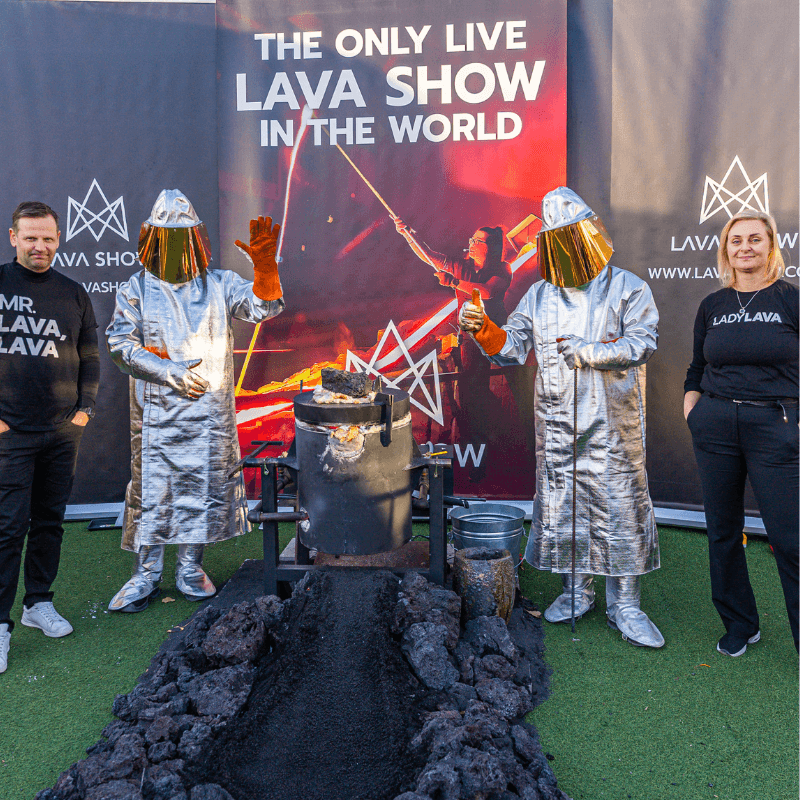2025/08/13
レイキャネス: 二つの世界を結ぶ裂け目
レイキャネス半島は、アイスランドの南西に位置し、遠くからは静かに見えます。低い丘が海に向かって広がっており、小さな漁村が海岸にしがみついています。しかし、地表の下では、北アメリカとユーラシアの2つの大陸の巨大なプレートが引き裂かれています。このゆっくりとした動きは地殻に亀裂を生じさせ、深い地下から溶岩を上昇させます。それが地表に達すると、長いシートとしてはき出し、高い噴煙をあげることなく広がります。
800年近くもの間、この地域は静かでした。しかし、2021年に地面が再び裂け、続くのは単発的な噴火ではなく、2025年まで続く一連の出来事でした。科学者たちは、これは数十年続く可能性のある新しい活動期の始まりであると信じています。
なぜレイキャネスが突然目覚めたのか
レイキャネスは中央大西洋海嶺、大西洋を貫通する巨大な海底山脈の上に位置しています。ここで、プレートが引き裂かれるにつれて、マグマが上昇して新しい地殻を形成します。この海嶺のほとんどは深い海の底ですが、アイスランドでは地表に現れ、島を貫通しています。
アイスランドの噴火は通常、何世紀もの静けさを経た突発的なもので、噴火サイクルが始まると数十年にわたって繰り返すことがあります。これらの現象は「フィッシュル噴火」と呼ばれ、長い亀裂を開き、時には数マイルにわたるためです。溶岩流は動きが速いことがありますが、一般的に爆発的な灰は少ないです。

アイスランドのレイキャネス半島の活火山カルデラの空撮視点。溶岩が通気孔から流れ出し、黒く焼けた景観を蛇行する様子。
新しい噴火のタイムライン:2021年から2025年まで
現在のサイクルは、地域を襲った地震の数週間の後、2021年3月に始まりました。その時点からレイキャネス半島は複数の噴火を経験し、それぞれ際立った特徴を持つものでした。以下は、これまでの噴火の明確な様子です:
2021年3月19日〜9月18日:ファグラダルスフィヤルの覚醒
2021年3月、数週間の振動の後、ファグラダルスフィヤル火山系の一部であるゲルディンガダリール谷に最初の亀裂が開きました。噴火は緩やかに始まり、小さな通気孔から溶岩が泡立ちます。時間の経過とともに、高い円錐形を形成し、溶岩は近隣の谷に広がりました。この噴火は、レイキャネスでは異例の長期間にわたり、約6ヶ月続きました。科学者にとっては、アイスランドのこの部分でマグマがどのように移動するかを長期間観察する貴重な機会でした。
この噴火は人々やインフラに危険を及ぼすものではなく、地質学者や冒険心に溢れたハイカーを魅了しました。訪問者は安全な距離を保ちながら、日々変わる谷の様子を見ることができました。噴火は9月に終わりました。
2022年8月3日〜22日:メラダリルの噴火
そのわずか1年後、メラダリルで再び噴火が始まりました。2021年の場所から東に位置し、このイベントは約三週間続き、亀裂が不毛の溶岩原に開き、溶岩がメラダリル谷に流れ込みました。地元の科学者たちは、マグマが以前の噴火と同じ深い源から来たように見えることを指摘し、システムが依然として活発であることを示しました。
この噴火は壮観でしたが、わずか三週間弱で終わり、高い溶岩噴水と激しい流れが新たな地形を刻みました。
2023年7月10日〜8月5日:リトリフルトルの火の夏
2023年には、活動がまだ続いていることは明白でした。7月にリトリフルトル近くで亀裂が開いたとき、それはこれまでの場所の北にありました。この噴火は高い溶岩噴水と速い流れを生成しました。科学者にとって、マグマが半島の下に新しい道を見つけているもう一つの兆候でした。訪問者にとって、この噴火は状況が急速に変化する可能性があることを思い出させるものでした。この噴火はほとんど警告なしで始まり、わずか1か月にも満たない期間で終わりました。
何千人もの訪問者が長い道のりを耐えて、この溶岩の光景を目撃しました。地質学者にとって、リトリフルトルはこの地域での噴火がどれだけ速く拡大し、強力になるかを証明するものでした。
ビデオ:グリンダヴィークの街を溶岩が包み込む
2023年12月18日〜21日:スンドヌーカガルが噴出
2023年後半、グリンダヴィーク近くで大きなことが起きていることを示す地震群と地面の変形がありました。12月18日、街の北で亀裂が開き、溶岩流が道路とインフラを脅かしました。
それは近年で最も強力な噴火で、以前のイベントの十倍強い溶岩流が発生しました。幸い、溶岩は町から離れた場所を流れましたが、3.7平方キロメートルの土地を覆いました。

レイキャネス半島の噴火で流れ出た溶岩がグリンダヴィークの端を覆い、いくつかの家を破壊し、アイスランドの景観に黒い傷跡を残しています。
2024年1月14日〜15日:ハガフェルの噴火
12月のスンドヌーカガルの噴火は数日で止まりましたが、2024年1月に同じエリアでまた亀裂噴火が始まりました。今回、溶岩はグリンダヴィークの端に達し、家を破壊し、避難を強制しました。これらの出来事は危険な方向へと転じ、噴火が人口が多い地域に近づきつつありました。
2024年2月8日〜10日:再びスンドヌーカガルが襲う
2月には、スンドヌーカガルのさらに北で3キロの亀裂が噴出。溶岩は温泉パイプラインを破壊し、一年で最も寒い時期に4日間暖房を止めてしまいました。この噴火は、地下水がマグマと相互作用することを示す可能性のある黒い灰と蒸気を生産したため、特異的でした。
2024年3月16日〜5月9日:ハガフェル
2024年初めには、スンドヌーカーシステムの下で圧力が依然として高かったため、3月にハガフェル付近で亀裂が開きました。溶岩が再びグリンダヴィークに向かって広がり、噴火中に高かったガス排出を監視するために科学者たちは民間保護チームと協力しました。5月末までに活動は止まりましたが、その地域は依然として不安定でした。
2024年5月29日〜6月22日:初夏の溶岩
5月末、スンドヌーカガルが再び噴火し今回は1キロの亀裂から始まり3.4キロに広がりました。溶岩噴水は50メートルの高さに達し、噴火はほぼ1か月続き、半島全体にもう一つの黒い跡を描きました。

レイキャネス半島の活火山カルデラから流れ出る溶岩が火の道を刻む。
2024年8月22日〜9月5日:軍事訓練場の噴火
8月の噴火は、かつてアメリカ軍の訓練場として使われていた場所で4キロの亀裂から始まり、不発弾の心配を引き起こしました。溶岩は当初急速に進みましたが、インフラに大きなダメージを与えることなく御されました。噴火は9月初めに終わりました。
2024年11月20日〜12月8日:驚きの噴火
この出来事は予測を裏切り、大きな地震群なしに起こりました。スヴァルセンギ地熱発電所では、僅かな圧力の変化が検出されただけでした。11月20日の深夜直前に、3キロ長の亀裂が開き、2週間以上にわたって溶岩を吐き出しました。
2025年4月1日:エイプリルフールの日の噴火
短く鋭く予想外、この噴火はわずか7時間続きました。そのタイミングのおかげでそのユーモラスなニックネームが付きましたが、その短さはレイキャネスが活発状態にあるという事実を減じませんでした。

2023年のアイスランドのリトリフルトル噴火のパノラマ空撮。燃える溶岩の噴水と輝く溶岩の川がレイキャネス半島の険しい地形を変える。
2025年7月16日〜8月5日:リトラ・スコグフェルイベント
2025年7月16日に、スンドヌーカー地域で別の噴火が始まり、長い溶岩流と再び強いガス排出が発生し、8月5日に終了しました。これらの出来事は、レイキャネスサイクルが完全に活発であることを増して確信させたものです。
レイキャネスの噴火が私たちに教えてくれること
噴火の連続を見てみると、いくつかのパターンが観察者にとって際立っています。噴火は、過去のアイスランドの主要なイベントと比較して相対的に小さい量ですが、その頻度は高いです。マグマが相互に連結した亀裂システムに沿って移動しているように見え、年ごとに場所を変えています。いくつかの噴火は、強い地震群の数時間以内に始まり、少ない前触れで始まります。
科学者にとって、これはリフト駆動の噴火がリアルタイムでどのように進化するかを研究する貴重な機会です。GPSと衛星データは、マグマが上昇する際の地面の膨張を追跡します。ガスセンサーは、噴火前後の排出レベルの変化を明らかにします。各イベントはパズルのもう一つのピースを追加します。
他のリフトゾーンとレイキャネスの比較
世界中の他のリフトゾーンは、いくつかの類似点を共有しています。例えば東アフリカ大地溝帯もフィッシュル噴火を起こしますが、その火山システムははるかに広い地域に広がっています。紅海リフトは、中央大西洋海嶺と同様に海底にありますが、エリトリアを含むアフリカの陸上で噴火を起こしています。アイスランドは、リッジが人口の多い島を通過するため、そのリフト噴火はより明白で、人々にとってより危険です。
噴火現場を訪れ、安全に過ごす方法
レイキャネスの噴火は多くの訪問者を引き付けていますが、実際のリスクがあります。新しい溶岩流は数ヶ月間熱を保ちます。特に二酸化硫黄のガス排出は、通気孔から遠く離れても危険なレベルに達することがあります。突然亀裂が開くことがあります。そして、噴火は突然、短い不安定の兆候の後で始まることがあります。
アイスランドの民間保護とアイスランド気象庁は、活動、危険、およびアクセス制限に関する最新情報を提供しています。訪問者はこれらの通知を注意深くフォローするべきです。安全な距離からでも、視界は印象的で、噴出口に近づかなくても噴火の威力を体験できます。
レイキャネス半島:先を見据えて
2021年~2025年の噴火がその物語の終わりとはほぼ確定的に言えません。過去のサイクルが何かを示すなら、レイキャネス半島は今後数十年間、噴火を見続ける可能性があります。これらは最近のイベントと同じエリアで起こるか、半島に沿った他の火山システムに変わる可能性があります。科学者にとって、リフトサイクルの開始を見る珍しい機会です。アイスランド人にとって、それは島の不安定な基盤を思い起こさせるものです。レイキャネス半島は、2つの世界の間で座っており、今後も何年も歴史を作り続けるでしょう。
地質学と火山学に関するさらなる情報源
ラバショーポッドキャストを聴いて、火山に関するすべてを深く掘り下げてください。お好きなポッドキャストアプリでラバショーまたはラバアカデミーを検索してください。









